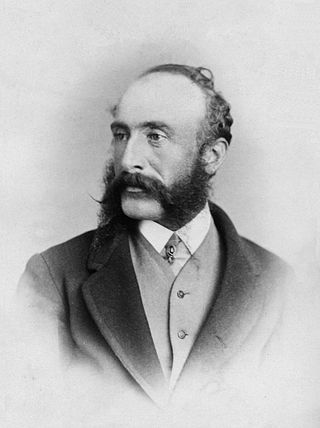
Sir Samuel Cunard, 1st Baronet, was a British-Canadian shipping magnate, born in Halifax, Nova Scotia, who founded the Cunard Line, establishing the first scheduled steamship connection with North America. He was the son of a master carpenter and timber merchant who had fled the American Revolution and settled in Halifax.

Hants County is a historical county and census division of Nova Scotia, Canada. Local government is provided by the West Hants Regional Municipality, and the Municipality of the District of East Hants.
Haliburton or Halliburton may refer to:

Joseph Howe was a Nova Scotian journalist, politician, public servant, and poet. Howe is often ranked as one of Nova Scotia's most admired politicians and his considerable skills as a journalist and writer have made him a provincial legend.
Windsor is a community located in Hants County, Nova Scotia, Canada. It is a service centre for the western part of the county and is situated on Highway 101.
Sam Slick is a character created in 1835 by Thomas Chandler Haliburton, a Nova Scotian judge and author. With his wry wit and Yankee voice, Sam Slick of Slicksville put forward his views on "human nature" in a regular column in the Novascotian. The twenty-one sketches were published in a collection entitled The Clockmaker or, also known as, the Sayings and Doings of Samuel Slick of Slicksville First Series in 1836 and supplemented by an additional 12 unpublished or new sketches. The book was Canada's first international bestseller and was hugely popular not only in Nova Scotia, but also in Britain and the United States.

The Novascotian was a newspaper published in Halifax, Nova Scotia, Canada. It became one of the most influential voices in the British North American colonies in its nearly one century of existence.

James Burton was an early British Egyptologist, known for his pioneering exploration and mapping of the Valley of the Kings, during which he became the first individual of the modern age to enter KV5; his pioneering excavations at Karnak, during which he discovered the Karnak king list; and his excavations at Medinet Habu, during which he was part of the team that discovered TT391.

Ezra Churchill : Nineteenth-century industrialist, investing in shipbuilding, land, timber for domestic and foreign markets, gypsum quarries, insurance companies, hotels, etc. As a politician he held positions in the Nova Scotia legislature and was appointed a Canadian Senator for the Province of Nova Scotia. Churchill was also a Baptist lay preacher.

Fort Edward is a National Historic Site of Canada in Windsor, Nova Scotia, and was built during Father Le Loutre's War (1749-1755). The British built the fort to help prevent the Acadian Exodus from the region. The Fort is most famous for the role it played both in the Expulsion of the Acadians (1755) and in protecting Halifax, Nova Scotia from a land assault in the American Revolution. While much of Fort Edward has been destroyed, including the officers' quarters and barracks, the blockhouse that remains is the oldest extant in North America. A cairn was later added to the site.
Sir Edward Kenny, was a Canadian politician and businessman. He co-founded the Union and Merchants' banks and served as Mayor of Halifax. He was a Conservative senator from 1867 to 1876.
Arthur Lawrence Haliburton, 1st Baron Haliburton was a Nova Scotia-born British civil servant. He was the first native Nova Scotian to be raised to the Peerage of the United Kingdom.
John Wesley Weldon was a lawyer, judge and political figure in the Province of New Brunswick, Canada. He represented Kent County in the Legislative Assembly of New Brunswick from 1828.
William Hersey Otis Haliburton was a lawyer, judge, and political figure in Nova Scotia. He represented Windsor Township in the Nova Scotia House of Assembly from 1806 to 1811, and represented Hants County from 1811 to 1824.

James Fraser JP was a Scottish-born businessman, judge and political figure in New Brunswick and Nova Scotia. He represented Northumberland County in the Legislative Assembly of New Brunswick from 1795 to 1818.

Dr Henry Burton was a British physician and chemist, who is famous for his identification of blue discolouration of the gums, the eponymous Burton line, as a symptom of lead poisoning.

William Valentine was a portrait painter and daguerreotypist in Halifax, Nova Scotia.

Robert Grant Haliburton Q.C., D.C.L. was a Canadian lawyer and anthropologist. He became famous after founding the Canada First organization that saw English Canadian society as the "heirs of Aryan northmen" and that the French Canadians were a "bar to progress."

The Old Parish Burying Ground is the oldest protestant cemetery in Windsor, Nova Scotia and one of the oldest in Canada. The graveyard was located adjacent to the first protestant church in Windsor (1788). The oldest marker of Rachel Kelley is dated 1771, twelve years after the New England Planters began to settle the area.
















